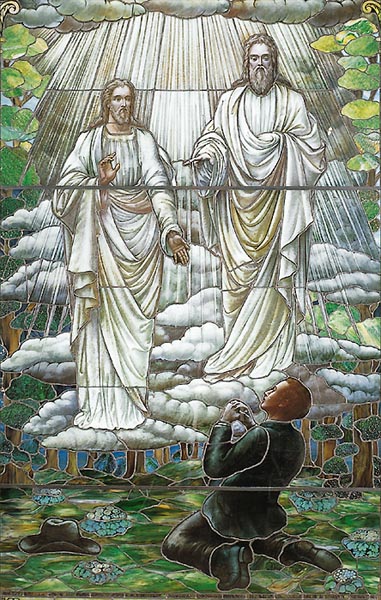Adam Powell, a Junior Research Fellow in Durham’s Department of Theology and Religion, reflects on the role of sounds and voices in Mormonism’s ‘First Vision.’ Adam writes:

‘…I made a fruitless attempt to pray, my tongue seemed to be swollen in my mouth, so that I could not utter, I heard a noise behind me like some person walking towards me…the noise of walking seemed to draw nearer, I sprung up on my feet and looked around, but saw no person or thing that was calculated to produce the noise…’
‘…a pillar of fire appeared above my head, it presently rested down upon me, and filled me with joy unspeakable, a personage appeared in the midst of this pillar of flame…another personage soon appeared like unto the first, he said unto me “thy sins are forgiven thee”, he testified unto me that Jesus Christ is the son of God; (and I saw many angels in this vision) I was about 14 years old when I received this first communication.’
These words are said to have been spoken by Joseph Smith, founder of Mormonism, as he described a formative theophanic (divine appearance) experience to a guest in 1835, approximately fifteen years after the supernatural event.[1]
Now, the experience is known to millions of faithful Mormons as the ‘First Vision’ – a sort of origin story for Smith’s role as religious prophet and restorer of eternal truths. As it goes, teenage Joseph is concerned about both individual sinfulness and the sinfulness of the various Christian denominations in his environment and absconds to a grove near his family’s farm to pray for knowledge of the truth. One of the ‘personages’ forgives Smith of his sins and, in later versions of the experience, informs Smith that all existing Christian churches are wicked and should be avoided.
As its name suggests, and in keeping with popular understandings of the inspirational events of many historical religious figures, emphasis is often on the visual elements of Smith’s experience: pillars of fire, angels, ‘personages’ (later identified as God the Father and Jesus Christ), etc. That the visions speak has not, of course, been overlooked by Mormon adherents and their religious opponents over the decades. After all, the words spoken by these divine entities are, ipso facto, of great significance for the truth claims and worldviews of members. However, Smith’s 1835 account in particular is noteworthy for at least two other reasons.
First, Smith’s guest, to whom he recounted the circumstances of the ‘First Vision,’ was Robert Matthews – a notable contemporary who had earned a reputation for his boisterous preaching, messianic claims, and, more importantly, for having had a ‘vision’ around 1830 of a flood destroying New York. Smith and Mathews, as two ‘visionaries’ swapping stories in the same time and place, provide a glimpse of America’s Second Great Awakening and the area of New York during the early nineteenth century that witnessed so many religious revivals and experienced so much religious fervour it became known as ‘the burned-over district.’[2] The prevalence of such visions plus the auditory details of Smith’s account serve to challenge a common timeline embraced by scholars such as Daniel Smith and Oliver Sacks that posits the eighteenth century as a turning point not only in western interpretations of auditory and religious phenomena but also in their frequency of occurrence (Sacks 2013: 60).[3] The argument seems to be that Enlightenment rationalism invented naturalistic/psychological notions such as ‘religious fanaticism’ and, consequently, such auditory and visual phenomena dwindled in number as cultural norms robbed them of their validity. Smith, Mathews, and New York’s ‘burned-over district’ may suggest otherwise.
Of course, highlighting the visual and auditory elements of Smith’s ‘First Vision’ as described in 1835 is also notable because it points to what we might call the multi-modal constitution of religious experience.[4] This singular instance of what nineteenth century doctors might have labeled ‘religious fanaticism’ or ‘delusion’ is comprised of numerous phenomena recognised by twenty-first century psychologists and psychiatrists: felt presences, voice-hearing, visions, etc. Similarly, religious adherents themselves might wish to underscore the complexity of such a pivotal moment – its emotions, sensory experiences, epistemological incursions, and the enormity of its faith-bolstering demonstration of authority/power. Thus, religious experience may be accurately characterised as a constellation of phenomena – whether natural or supernatural. Likewise, to speak of the ‘visions’ of the ‘visionaries’ may be to mislead ourselves and to diminish substantially the meaning of the full experience for both the original figure and subsequent devotees. Mormonism’s ‘First Vision’ was, and is, so much more than that.
[1] They were certainly recorded in a journal at the time by Warren Parrish, a close associate of Smith who served as scribe for the religious leader. Smith also had a part in three other recorded versions of the ‘First Vision’ experience, but this 1835 account (the second of four) is the only one to articulate Smith’s.
[2] Whitney R. Cross, The Burned-over District (Ithaca: Cornell University Press, 1981), 4.
[3] Daniel B. Smith, Muses, Madmen, and Prophets (New York: Penguin Press, 2007), 13-14; Oliver Sacks, Hallucinations (New York: Vintage Books, 2013), 60.
[4] Even when scholars are highlighting the prevalence of such experiences in the nineteenth century, they often discuss them in terms of ‘visions’. See, Ann Taves, Fits, Trances, and Visions (Princeton University Press, 1999).
